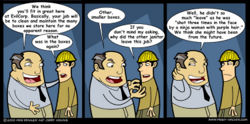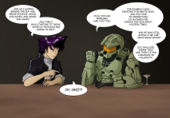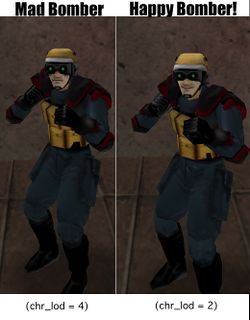Easter eggs
An Easter egg is a secret message placed in a game by a developer. Typically Easter eggs speak to the audience directly, make an inside joke, or contain vanity messages such as hidden credits. Oni contains a few in-jokes, and a lot of references to other Bungie games.
References
Old Man Murray

Old Man Murray was a gaming blog with feisty criticism of the industry; its writers would later work on Psychonauts and the Portal games. In one of their most famous articles, they suggested that the ultimate quality of a game could be gauged by a single criterion, a time measurement called "Start to Crate" or "StC": the amount of time from the start of the game until the first crate (or barrel, etc.) is sighted. The smaller the time, the worse the game, as the use of crates to adorn a level demonstrates that the developers have run out of ideas.
Oni's first level is a warehouse and it is literally full of crates, barrels and containers. You can see a stack of crates right from where you start the level (there are also crates in the training course, but not in the first room). On one of the first crates you see in the Warehouse, there's a label saying "-OMM- TTC 1.1"...

|
...or, in other words, "-Old Man Murray- Time To Crate 1.1 [seconds]"; pretty bad, needless to say). The same label also features a reference to Developer Mode: "THE DAY IS MINE!!" is written along the lower side of the label.
Marathon
The Marathon series began and ended before Oni's release, and was the major source of most new Bungie fans in the ten years before Bungie released Halo.
Marathon symbol
The first Oni trailer featured Marathon symbols on the crates (yes, it also took place in a warehouse full of crates :-). In-game, the Marathon symbol can be seen on the hull of the TCTF computer Damocles in CHAPTER 06 . COUNTERATTACK and CHAPTER 13 . PHOENIX RISING (see texture TXMPTC_SHCOMP2 as well as this concept art). Fans certainly did not miss this, so Harry brought it up in his interview with Alex Okita:
- Harry
- Who did the first Oni trailer? The one yanked from the web rather often.
- Alex
- I did the direction for it, Steve [Abeyta] and Chris [Hughes] did all the animation.
- Harry
- And the crate with the Marathon logos. A nice touch...You made Hamish [Sinclair] really paranoid with that one...
- Alex
- (grinning) That was our goal.
- Harry
- That's why that picture of Damocles has a small Marathon logo on it, huh?
- Alex
- Yeah (laughs) It kicks up some dust.
- Harry
- Any significance to the name?
- Alex
- It's kind of [a] cool name.
- Harry
- It's not gonna drop on your head or anything...
- Alex
- No, heh. Although it is kind of neat; it's a giant supercomputer which has all these cables going through the ceiling.
Wave Motion Cannon
A weapon called "Wave Motion Cannon" was cut from Marathon. Like the joke weapon "Pirated Copland beta", it is just a string in the resources, not a usable weapon. As we know, the Wave Motion Cannon is the biggest weapon in all of Oni, and the only one to support 2 firing modes.
Frog blast the vent core!
Comm Troopers occasionally say "OK, OK, don't frog blast the vent core!", which is a reference to the "assimilated" or "simulacrum" BOBs in Marathon. Intended to blend in with regular civilians (the inhabitants of the Marathon, who were "Born On Board") until they got close enough to the player to detonate themselves, the simulacrums would attempt to shout phrases similar to regular BOBs -- but their odd expressions would give away that something was not right about them. The biggest warning was when one would scream, "Frog blast the vent core!"
Comm Troopers can also scream, "She's everywhere!" (referring to Konoko); another phrase screamed by the enemy BOBs was, "They're everywhere!" Not coincidentally, Doug Zartman was the voice actor for both Marathon's BOBs and Oni's Comm Troopers.
- Zartman described the inspiration for the quote in the Marathon Scrapbook
- The idea was that some of the assimilated Bobs become insane from their conversion and run around yelling nonsense. Alex said to me ‘say something random’, and that phrase tumbled from my lips. Totally spontaneous. While I could have sat down and thought up something more random than that, it worked out well, since it sounds close enough to a real sentence that it kept people guessing and generated some fascinating (and totally wrong) discussion about what the phrase was and its meaning. One popular theory was ‘God bless the Marine Corps!’, which was a fair guess, but still wrong.
It was very popular to say this in the text chat of a networked Bungie game; the sheer randomness of this phrase means it can be used at any time.
Rampancy
The word rampant had existed before Bungie, but the specific concept of "rampancy", referring to an AI that goes out of control and acts with free will, was coined and subsequently developed by the Marathon team (this concept was revisited by 343 Industries for Halo 4). The three/four stages of a rampant AI are Melancholia, Anger, Jealousy, and Metastability. An egotistical level of self-awareness accompanies the development of the AI's personality. The tirades of the Deadly Brain (only seen in the subtitles) are a reference to this, as shown by Shinatama's statement, "Clearly, it's gone rampant". However, a rampancy in Marathon takes place when an AI is exposed to large amounts of data for a long enough period of time. Here, the Deadly Brain is a disembodied human brain, and it is essentially just going crazy because Konoko "decoupled its core logic" (how exactly does one do that to a human brain, anyway?).
Myth
The second Myth game was Bungie's most recent release before Oni in 2001, and about as popular as the Marathon series.
Balor
Forklifts in the Warehouse are labeled "BALOR", and Balor is the name of a Celtic god, but it is also the name taken by the incarnation of "the Leveler" in Myth.
- (adapted from Wikipedia)
- Balor is also the name Connacht the Wolf adopts when he becomes the new Leveler in the Myth computer game series. During the seventeenth year of the Grear War, he interrogated Alric, who was previously captured by The Deceiver. In that event Alric learned by chance that the Fallen Lords were bound to Balor. Towards the end of the war, Alric and the Legion went to Rhi'anon, Balor's fortress, and planted the Myrkridian standard they had found inside the Tain, an act that was meant to enrage The Leveler. During the Last Battle, the Avatara immobilized Balor with the aid of the Eblis Stone, thus allowing the barbarians of the Legion to behead the warlord. In the end, Balor's head was thrown into the Great Devoid, ending his life and his sway over the surviving Fallen.
Soundtrack
A number of ambient themes from Myth: The Fallen Lords and Myth II: Soulblighter were reprised in Oni:
- Heart of the Stone (from Myth, reprised in Myth II as Gonen's Bridge)
- Smiths of Muirthemne (from Myth)
- A Traitor's Grave (from Myth)
- The Deceiver (from Myth II)
See Music/Myth for details.
Halo
This one is actually a back-reference to Oni from a later game. Oni doesn't refer to Halo (unless you count the fan project AE:BGI), but Halo features an entity called ONI. It stands for Office of Naval Intelligence. A military intelligence service called the Office of Naval Intelligence actually exists in the real world: it's the oldest continuously operating intelligence service in the United States (in operation since 1882). It seems likely that Halo develops on that longevity and tries to imagine what influence today's ONI would have in the 2550s.
There has been a lot of speculation around Halo's ONI, most of which you can see HERE. You can directly access the entry which draws the parallel between Halo's ONI, the Japanese oni myth, and Bungie's "Oni" HERE.
Secrets
Hidden stuff
There are quite a few more-or-less hidden items or characters in Oni. However, few of them qualify as Easter eggs... as most of those are uncovered with a systematic exploration of the level, or by careful observation.
Secret Striker
A special mention goes to the secret Striker in CHAPTER 01 . TRIAL RUN. If you pass the first door, then take the stairs to the top floor, and jump onto the cabin of the forklift, a Striker will appear (see this YouTube video). When killed, he drops 3 items (hypo spray, phase cloak, force shield). The phase cloak and the force shield are otherwise not encountered before CHAPTER 03 . PUZZLE PIECES, and the secret Striker comes before the first Striker you see normally (after you find Chung). The very improbable encounter and its extraordinary reward qualify this secret Striker as one of Oni's few Easter eggs.
Mad/Happy Bomber
Normally Mad Bombers have a neutral facial expression, but at the "medium" level-of-detail (LOD) of the character geometry, the texture coordinates are inconsistent with the other LODs, and the bomber appears to be smiling (the helmet is a bit messed-up too):
It is not clear whether this is an actual Easter egg intended by the modeler, or just some careless texturing that was never noticed or fixed by the developers. Then again, if it was noticed, but not fixed, then it qualifies as intended. ^_^
Scripts and game data
The day after
In CHAPTER 03 . PUZZLE PIECES, there's this console right before the acid room:
Lab Management is pleased to announce that this facility has gone 263 DAYS without an accident! This safety achievement is just one of the many reasons why VAGO is THE industry leader in employee satisfaction. Remember: Work hard, but work safe! (ref.BIOTECHNOLOGY TODAY vol.XXI) |
Febtober
A trigger volume in CHAPTER 02 . ENGINES OF EVIL has the name "febtober", which is a reference to a Saturday Night Live "Celebrity Jeopardy!" sketch where "Sean Connery" guesses that the month of the year starting with "Feb" is "Febtober". Any possible additional in-joke at Bungie concerning this "month" is unknown. Triggering "febtober", which is done by jumping off the walkway with the turret at the end, spawns a Striker with a plasma rifle who patrols the corridor near the turbines seen in the level's splashscreen.
Unused resources
Though not Easter eggs because they weren't deliberately hidden in order for players to discover them, resources unused in the actual game can sometimes be found by looking through the level scripts and game data. For instance, a music theme called "The Hunt" is available in CHAPTER 13 . PHOENIX RISING but was supposed to play in CHAPTER 12 . SINS OF THE FATHER, and additional characters can be spawned for the boss battle in CHAPTER 14 . DAWN OF THE CHRYSALIS. A more famous example is an undressing animation for Konoko that was intended to be used in a cut feature where Konoko could go undercover by changing into different clothes. This was found before Oni was even released, by inspecting the demo's data. More unused animations are listed HERE.
Iron Demon
The Iron Demon's walking sounds can be found in Oni's global resources.
Developer Mode
As mentioned above, a reference to Developer Mode (the cheat code thedayismine) is found on a crate label in CHAPTER 01 . TRIAL RUN, along with the Old Man Murray reference. Developer Mode was believed to be absent from the retail game builds, but was eventually unlocked in 2006.
Developer names
The impact texture for the Mercury Bow contains the name of Chris Hughes, one of the texture artists. His name is also preserved in the Hughes Death Adder SMG, the standard weapon for Syndicate Strikers. Konoko's own standard weapon is the Campbell Equalizer Mk4, and the name "Campbell" can be found in a few places connected to Bungie: the Campbell family members mentioned in the credits, the city of Campbell, CA (arguably the true location of Bungie West, not San Jose), and Steve Campbell, founder of Bungie.org and Oni Central.
More features
Stuff like breaking glass with combos and throws, or glass shards causing damage... that wasn't in the original Oni, and wasn't really "locked" either: they are all-new features (supported by the engine, but which Bungie didn't use). Various mods exploring the possibilities of the engine can be found in the Anniversary Edition.

